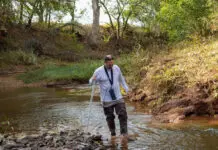Oklahoma is home to 20 animal species that are considered endangered or threatened. Some of these species, like the Whooping Crane, are only temporary residents, passing through the state during yearly migrations or stopping for a few months to breed. Others, like the small catfish Neosho madtom, are only found primarily in Oklahoma.
One ongoing conservation program in the state concerns the red-cockaded woodpecker. These black-and-white striped birds make their homes in live, mature, old-growth pine trees in McCurtain County Wilderness Area in southeast Oklahoma.
“In Oklahoma we have only one population of woodpeckers left,” says Mark Howery, wildlife biologist with the Oklahoma Department of Wildlife Conservation. “Since 1992 we’ve been working to improve the safety of the trees and the habitat around the trees.”
Some of these measures include building guards around the bottom of the trees to deter predators and ensure the health of the pine forest these birds call home. There is also an effort to diversify the Oklahoma population of woodpeckers. There are only about 60 living in Oklahoma and about 6,800 in the U.S.
The black-capped vireo’s recovery is a great success story of Oklahoma conservation. The only population in Oklahoma is in the Wichita Mountain Wildlife Refuge and on Fort Sill near Lawton. The birds only produce a few offspring every year, and its population was ravaged by habitat destruction and brown-headed cowbirds. These cowbirds lay their eggs in the nest of black-capped vireos, and when the much larger cowbird chicks hatch, they kill or overpower the vireo chicks and are raised by the vireo mother.
Efforts to combat the cowbird population and to preserve the scrubland of the Wichita Mountain Wildlife Refuge have been incredibly successful.
“Over the last 25 years, the population has grown from about 85 birds to around 4,000 birds,” says Howery.
Even with success stories like these, conservationists in Oklahoma and around the country have an uphill battle to fight.
The U.S. Congress apportions around $100 million annually for endangered species conservation, and only between $80,000 and $100,000 of that money makes its way to Oklahoma each year. With funding like this, the state’s conservationists are forced to spend the money where it can do the most good, which means that many of the state’s 11 threatened or endangered species of fish, crustaceans and mollusks are left out due to the difficulty of working in state waterways.
“I don’t want to say that $100 million a year is chump change, but when you spread $100 million across 900 species, there’s not a lot to go around,” says Howery.
OKLAHOMA'S ENDANGERED SPECIES
Seasonal
Whooping Crane (Grus americana): This unique species of bird resides in Oklahoma during the spring and fall and can usually be found in wetland areas.
Black-capped Vireo (Vireo atricapilla): The tiny songbird passes through Oklahoma between April and September, settling in bushy thickets and forested areas.
Permanent
Gray Bat (Myotis grisescens): The gray bat lives in the Ozark region of Oklahoma, occupying various caves throughout the summer and winter months.
Indiana Bat (Myotis sodalis): These bats live isolated in forested habitats and reside in caves only during hibernation.
Ozark Big-eared Bat (Corynorhinus townsendii ingens) Ozark Big-eared bats are not migratory; their movement is almost always confined within the limestone caves in which they reside.
Piping Plover (Charadrius melodus): This bird resides around wetlands and has diminished in population due to dam construction.
Interior Least Tern (Sterna antillarum): Terns reside in small groups along rivers and lakes.
Red-cockaded Woodpecker (Picoides borealis) This species of bird nests in pine woodlands, much of which have been infected with various fungal diseases.
Arkansas River Shiner (Notropis girardi): Ironically, most Arkansas River Shiners inhabit the Canadian River in Oklahoma, eastern New Mexico and western Texas.
Ozark Cavefish (Amblyopsis rosae): The Ozark Cavefish lives in subterranean water, much of which is threatened by pollution.
Neosho Madtom (Noturus placidus): Found in the Neosho River system, this species of Madtom spends most of its life in regions of water that are inaccessible to other species.
Leopard Darter (Percina pantherina): Leopard Darters travel from shallow, clear pool regions in the summer, fall and winter months, to relatively deep riffles in the spring.
American Burying Beetle (Nicrophorus americanus): The American Burying Beetles inhabit a variety of different regions throughout the year, reproducing each spring and summer inside large mammal carcasses.
Ouachita Rock Pocketbook (Arkansia wheeleri): This treasured freshwater mussel lives primarily in he Kiamichi River in Oklahoma, the Little River in southeastern Oklahoma and southwestern Arkansas and the Ouachita River in Arkansas.
Winged Mapleleaf (Quadrula fragosa): This beautifully shaped mussel exists in shallow rivers and streams all throughout Oklahoma.
Scaleshell (Leptodea leptodon): This freshwater mussel usually lives at the bottom of fast-flowing water.
– Nathan Porter

























